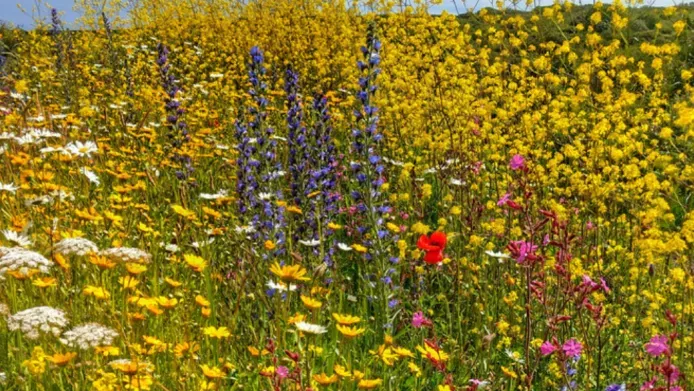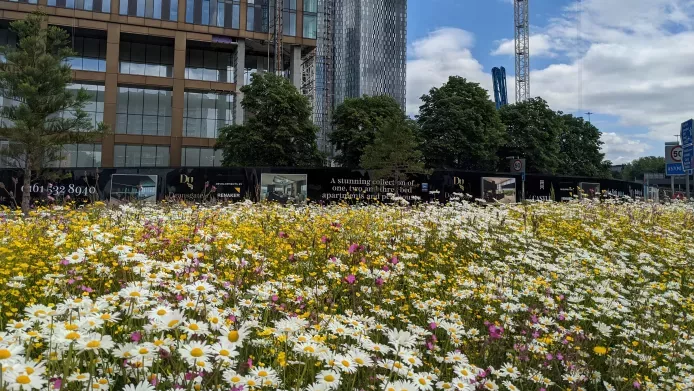Half of Britain and Ireland’s native plants have declined since the 1950s, meaning that in the UK there are now more non-native plants growing wild than native species (BSBI 2020).
What does ‘native’ mean?
The term ‘native’ is used to describe a plant species that arrived in the UK independently of human intervention.
Although we sometimes speak about native plants in terms of country, UK native species are not necessarily native to every area of the UK – many naturally occur only in certain areas.

Black Mountain hawkweed, or Tawe hawkweed (Hieracium tavense), is a very rare species endemic to Wales.
Why have native plants declined?
Native plants that have been most affected by climate change in recent decades include those that are adapted to infertile conditions and low competition. They have declined because of:
- Changes to agricultural practices
- Drainage of wetland habitats
- Eutrophication from other human sources, such as atmospheric pollution
- Climate change, particularly warmer winters
The UK has lost 97% of UK wild flower meadows*
Wildflower meadows are one of the rarest habitats in the UK, full of native plants and wildlife.
*Since the 1930s

'British wildflowers are under threat and therefore so are the pollinators they feed. Not only is it heartbreaking to lose the beauty and colour these native flowers give the UK landscape, but the plight of pollinators has a very real impact on the food we eat ourselves.'
Royal Botanic Gardens, Kew Director, Richard Deverell
Why does climate change affect native plants?
Climate change and biodiversity loss are inseparably connected to one another.
As temperatures warm in the UK and Ireland, native plants that are distributed in the north are retreating even further north and to higher altitudes to areas where there is less competition with plants that enjoy higher temperatures. Therefore, they are occupying a smaller habitat range.
Southern native plant species, on the other hand, have declined less, as they have been able to creep northwards as temperatures rise.
UK Native species in decline
The following plants are all examples of declining species:

Alpine lady-fern (Athyrium distentifolium) is a small, delicate fern that is native to the UK. It is found in upland areas, typically above 600 metres in altitude. The fern has pale green, arching fronds that are up to 30 cm long. The fronds are divided into leaflets that are arranged in an overlapping fashion. Alpine lady-fern is a snow-tolerant species and is often found growing in scree slopes and other rocky areas. It is a nationally scarce plant, but it is relatively common in the Highlands of Scotland.
- The fern is also known as alpine marsh-fern and mountain lady-fern.
- Alpine lady-fern is a deciduous fern, meaning that it loses its leaves in winter.
- The fern prefers moist, well-drained soils.
- Alpine lady-fern is a popular ornamental plant and is often grown in gardens.

Corn spurrey (Spergula arvensis) is a small, annual plant that is native to the UK. It is found in a variety of habitats, including arable land, waste ground, and roadsides. The plant has slender, reddish-brown stems that can grow up to 60 cm tall. The leaves are narrow and linear, and they are arranged in whorls up the stem. The flowers are small and white, and they are clustered at the ends of the stems. Corn spurrey flowers from June to August.
- The plant is also known as stickwort, starwort, and spurrey.
- Corn spurrey is a summer annual, meaning that it germinates in spring and dies in autumn.
- The plant is a prolific seed producer, and its seeds can remain viable in the soil for several years.
- Corn spurrey is considered a weed in some agricultural settings, but it is also a food plant for some insects.

Devil’s-bit scabious (Succisa pratensis) is a tall, herbaceous perennial wildflower that is native to the UK. It is found in a variety of habitats, including meadows, marshes, and woodland edges. The plant has a single, erect stem that can grow up to 1 m tall. The leaves are lanceolate and arranged in a basal rosette. The flowers are purple or mauve and are arranged in a pincushion-like head. Devil's-bit scabious flowers from July to September.
- The plant is also known as sheep's bit, devil's bit, and mouse ears.
- Devil's-bit scabious is a nectar-rich plant that is attractive to bees, butterflies, and other insects.
- The plant is a food plant for the marsh fritillary butterfly.
- Devil's-bit scabious is a traditional medicinal plant that has been used to treat a variety of ailments, including fever, coughs, and wounds.

Harebell (Campanula rotundifolia) is a small, delicate wildflower that is native to the UK. It is found in a variety of habitats, including meadows, heaths, and roadsides. The plant has a slender, upright stem that can grow up to 30 cm tall. The leaves are oval or heart-shaped and are arranged in a basal rosette. The flowers are pale blue or violet and are bell-shaped. Harebell flowers from June to September.
- The plant is also known as bluebell, lady's thimble, and witch's thimble.
- Harebell is a nectar-rich plant that is attractive to bees, butterflies, and other insects.
- The plant is a food plant for the small blue butterfly.
- Harebell is a traditional medicinal plant that has been used to treat a variety of ailments, including fever, coughs, and wounds.

Heather (Calluna vulgaris) is a low-growing, evergreen shrub that is native to the UK. It is found in a variety of habitats, including heathlands, moorlands, and bogs. The plant has slender, wiry stems that can grow up to 50 cm tall. The leaves are small and needle-like, and they are arranged in opposite pairs. The flowers are pink or purple and are arranged in small, terminal clusters. Heather flowers from August to October.
- The plant is also known as ling, bell heather, and heather bell.
- Heather is a popular ornamental plant and is often grown in gardens.
- Heather is a source of food for bees, butterflies, and other insects.
- Heather honey is a dark, aromatic honey that is produced from the nectar of heather flowers.

Lousewort (Pedicularis sylvatica) is a small, herbaceous biennial plant that is native to the UK. It is found in a variety of habitats, including heaths, moors, and grassy meadows. The plant has a semi-erect stem that can grow up to 15 cm tall. The leaves are opposite, with short stalks, rather thick and often tinged pink or purple. The leaf blades are small, triangular-lanceolate to linear, with pinnate lobes and toothed margins. The inflorescence is a raceme with usually four to six flowers open at a time. The flowers are pink or purple, with a beaked upper lip and a three-lobed lower lip. Lousewort flowers from April to July.
- The plant is also known as wood betony, wood lousewort, and louse bane.
- Lousewort is a hemi-parasite, meaning that it obtains some of its nutrients from the roots of other plants.
- The plant is a source of food for bees, butterflies, and other insects.
- Lousewort has a long history of medicinal use, and it has been used to treat a variety of ailments, including fever, coughs, and wounds.

Opposite-leaved pondweed (Groenlandia densa) is a rare and endangered aquatic plant that is native to the UK. It is found in lakes, rivers, and canals with clear, base-rich water. The plant has opposite, linear leaves that are arranged in whorls up the stem. The leaves are up to 3 cm long and 1 mm wide, and they have a distinctive yellow-green color. The plant's stem can grow up to 1.5 meters long and can be either floating or submerged, depending on the depth of the water. The flowers are small and inconspicuous, and they are arranged in spikes at the top of the stem. They typically bloom in late spring to early summer.
Opposite-leaved pondweed is a threatened species due to a number of factors, including habitat loss, pollution, and invasive species. The plant is protected by law in the UK, and there are a number of conservation efforts underway to protect its remaining populations.
- The plant is also known as opposite pondweed and Potamogeton densus.
- Opposite-leaved pondweed is a perennial plant.
- The plant is a food source for some insects, including the damselfly Lestes sponsa.
- Opposite-leaved pondweed is a popular ornamental plant and is often grown in aquariums.

Tubular water-dropwort (Oenanthe fistulosa) is a herbaceous perennial plant that is native to the UK. It is found in a variety of wetland habitats, including ponds, lakes, rivers, and ditches. The plant has a hollow, ridged stem that can grow up to 1 m tall. The leaves are pinnate, with oval or lanceolate leaflets. The flowers are small and white, and they are arranged in umbels. Tubular water-dropwort flowers from June to September.
Tubular water-dropwort is a declining species in the UK, and it is now considered to be a Vulnerable species. The main threats to the plant are habitat loss, pollution, and the introduction of invasive species. Tubular water-dropwort is a protected species in the UK, and there are a number of conservation efforts underway to protect its remaining populations.
- The plant is also known as marsh water-dropwort, hollow-stemmed water-dropwort, and field water-dropwort.
- Tubular water-dropwort is a member of the carrot family (Apiaceae).
- The plant is a food source for some insects, including the damselfly Lestes sponsa.
- Tubular water-dropwort is a poisonous plant, and its consumption can cause vomiting, diarrhea, and other symptoms.
Why are UK Natives important?
UK native species have been adapting and coevolving alongside other native flora and fauna for thousands of years, so they are well suited to our ecosystems. Therefore native plants are particularly important for supporting the insects and other wildlife that are found in the UK, such as hedgehogs and birds.
Plants are where life begins – when native species decline, so does our pollinator population, biodiversity, and our food supply.
It’s not all doom and gloom!

Some UK native species are thriving! Plant Atlas 2020 shows that there are native species that are expanding and growing in more areas than in previous decades. Examples include Bee Orchid (Ophrys apifera), Early Meadow-grass (Poa infirma) Mossy Stonecrop (Crassula tillaea).
'Most important is the need to put plants at the heart of conservation initiatives.'
BSBI 2020.
How can you help?
Spread the word
Help us tell people about why native plants are so important! Share this page with your friends and followers.
Sow and grow
Even in the smallest spaces, such as windowsills, you can grow UK native wildflowers and help support our pollinators.
Get together
Volunteer with a group near you on a community project.
Get creative
Whether you fancy doing some drawing, writing, singing, or anything else, why not make UK native plants your theme? Who knows what you might learn and who you might inspire.



